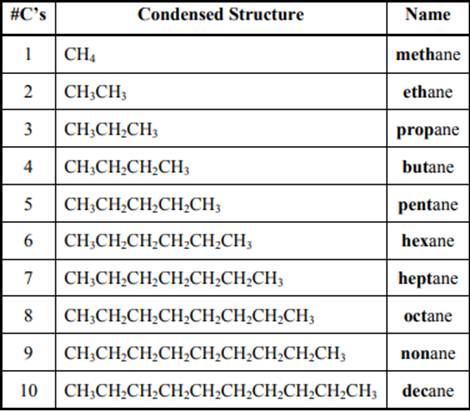
Custom eBook for Organic Chemistry
2nd Edition
ISBN: 9798214171104
Author: Straumanis
Publisher: Cengage Custom
expand_more
expand_more
format_list_bulleted
Concept explainers
Question
Chapter NW1, Problem 12CTQ
Interpretation Introduction
Interpretation: The information conveyed by “di” and “tri” in below figure should be given.

Concept introduction: The IUPAC name begins with prefix to designate the number of
The IUPAC system for nomenclature of straight hydrocarbon makes use of table given as follows:

As per IUPAC recommendations, longest chain found in a continuous manner in a branched molecule is chosen as parent chain. All the side chains are named in alphabetical order.
Expert Solution & Answer
Want to see the full answer?
Check out a sample textbook solution
Students have asked these similar questions
Draw the products of the reaction shown. Electron flow is indicated with curved arrows.
H.
CH3
ČH3
• Include all valence lone pairs in your answer.
• Include counter-ions, e.g., Na*, I', in your submission, but draw them in their own
separate sketcher.
• Draw one structure per sketcher. Add additional sketchers using the drop-down
menu in the bottom right corner.
• Separate multiple products using the + sign from the drop-down menu.
opy
ate
OF
How does pentane’s boiling point compare with the boiling points of the alcohol and the aldehyde in Model 1?
Can molecular weight differences account for the observed differences in boiling points?
Propose an explanation for the observed differences in boiling points.
Compare the boiling points of the ketone and carboxylic acid. Propose an explanation for the observed differences in boiling points.
Why do carboxylic acids have the highest boiling point, even higher than alcohols? explain this observation.
—
Your answer is partially correct.
CH3
Edit Drawing
✓no reaction
H₂
?
Chapter NW1 Solutions
Custom eBook for Organic Chemistry
Ch. NW1 - Prob. 1CTQCh. NW1 - (E) Write a correct name below each of the...Ch. NW1 - (E) What suffix do all the names in Model 1 have...Ch. NW1 - (E) What prefix stands for eight carbons?Ch. NW1 - Prob. 5CTQCh. NW1 - Prob. 6CTQCh. NW1 - Prob. 7CTQCh. NW1 - Prob. 8CTQCh. NW1 - Prob. 9CTQCh. NW1 - Use Model 1 to propose names for three-, four-,...
Ch. NW1 - Prob. 11CTQCh. NW1 - Prob. 12CTQCh. NW1 - Prob. 13CTQCh. NW1 - Name the following alkanes.Ch. NW1 - (Check your work.) Explain what is wrong with each...Ch. NW1 - Prob. 16CTQCh. NW1 - Draw the following alkanes a....Ch. NW1 - Prob. 18CTQCh. NW1 - Draw structures that correspond to the following...Ch. NW1 - For mono-substituted cycloalkanes the “1” is not...Ch. NW1 - Prob. 21CTQCh. NW1 - Prob. 22CTQCh. NW1 - Prob. 23CTQCh. NW1 - Prob. 24CTQCh. NW1 - Prob. 25CTQCh. NW1 - Write the name of the molecule on the left using...Ch. NW1 - Prob. 1ECh. NW1 - Prob. 2ECh. NW1 - Name each of the following structures.
Knowledge Booster
Learn more about
Need a deep-dive on the concept behind this application? Look no further. Learn more about this topic, chemistry and related others by exploring similar questions and additional content below.Similar questions
- Complete the following statements so that they are true. Ry value. Ry value. R; value. Ry value. a. A more polar compound has a b. A less polar compound has a c. A more polar solvent causes a d. A less polar solvent causes a e. To increase the Ry of a spot, you should add more of which solvent, hexanes or ethyl acetate?arrow_forwardDraw the products of the reaction shown. Electron flow is indicated with curved arrows. CH₂ H₂C Ⓒ. • Include all valence lone pairs in your answer. . Include counter-ions, e.g., Na*, F, In your submission, but draw them in their own separate sketcher. • Draw one structure per sketcher. Add additional sketchers using the drop-down menu in the bottom right corner. • Separate multiple products using the + sign from the drop-down menu. CH₂ 981 O ChemDoodle #₂ falt Next Email Instructor Savarrow_forward
Recommended textbooks for you
 Organic Chemistry: A Guided InquiryChemistryISBN:9780618974122Author:Andrei StraumanisPublisher:Cengage Learning
Organic Chemistry: A Guided InquiryChemistryISBN:9780618974122Author:Andrei StraumanisPublisher:Cengage Learning

Organic Chemistry: A Guided Inquiry
Chemistry
ISBN:9780618974122
Author:Andrei Straumanis
Publisher:Cengage Learning